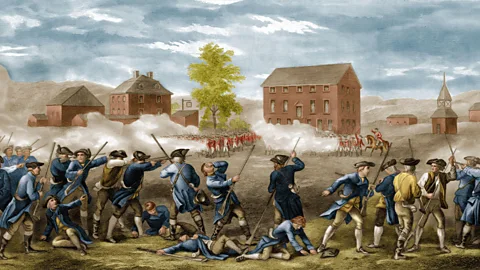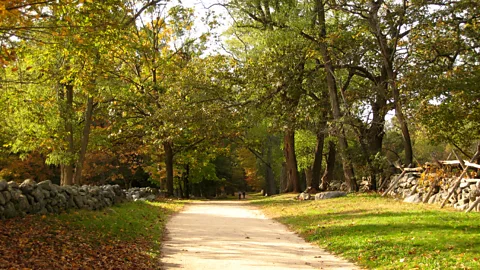The quiet Massachusetts towns that sparked a revolution
 Alamy
AlamyTwo hundred and fifty years ago, several small farming communities rose up against the British and helped form a new nation. Now, the towns are gearing up to party like it's 1775.
On 19 April 2025, Lexington, Concord and two other neighbouring towns north-west of Boston will mark the 250th anniversary of the chilly spring day in 1775 when Massachusetts militiamen faced off against British forces in a clash that launched the US on a path to independence.
The fateful die was cast when Paul Revere arrived on horseback to the small farming community of Lexington to warn leaders that British soldiers were marching from Boston to seize colonial military supplies stored in Concord, a few miles down the road. When the British arrived, they found a small force of local militiamen, known as Minutemen, waiting in the dawn light.
No one knows who fired the first shot, but when the skirmish was over, eight Minutemen lay dead, along with one British soldier. The British forces marched on to Concord where they met a larger force of Minutemen by the North Bridge. After fierce fighting and significant losses on both sides, the British retreated. Marching back to Boston, British troops faced a running battle as the towns of Lincoln, Lexington and Menotomy (now Arlington) had mustered their militias to mount an organised resistance.
The American War of Independence had begun.
 Alamy
AlamyEvery year, the events of 19 April are celebrated with various historical reenactments and other special events in these small Massachusetts towns. But with additional celebrations planned in honour of the 250th anniversary, organisers are expecting this year's festivities to draw more travellers than ever before to what many call "the birthplace of American liberty".
This year's festivities kick off on 18 April with a commemoration of Paul Revere's famous midnight ride to Lexington, followed by a reenactment of the Battle of Lexington the following morning. On 21 April, an event honouring the opening shot of the Battles of Lexington and Concord will take place at Concord's North Bridge, while a host of special exhibits, lectures and parades will take place throughout April.
Two and a half centuries after shaping American history, Lexington's colonial heritage remains a defining presence, offering year-round visitors a window into the past. The Lexington Battle Green, where the Minutemen met the British forces, remains the centre of the quiet, 34,000-person community. A statue of farmer-turned Minuteman captain John Parker stands at one end, facing the direction from where British troops approached. Elsewhere, a stone marker on the Lexington Battle Green is engraved with the words Parker is said to have uttered to his men: "Don't fire unless fired upon, but if they mean to have a war, let it begin here." A memorial obelisk marks the spot where the Minutemen killed in the battle were reburied after being moved from their original graves in the nearby Old Burying Ground.
 Annika Hipple
Annika HippleNearby, the Lexington Visitors Center provides an overview of the events of 19 April along with a detailed diorama of the battle. From April through October, Liberty Ride trolley tours whisk travellers from the Visitors Center to historical sites in Lexington and Concord along the Battle Road that connects the two towns.
Next door to the Visitors Center, Buckman Tavern, where the Minuteman gathered before the clash, is one of three historic houses maintained by the Lexington Historical Society. The other two include Munroe Tavern, which was occupied by retreating British soldiers after the battle; and the Hancock-Clarke House, where patriot leaders John Hancock and Samuel Adams were staying when Revere arrived to sound the alarm.
More like this:
• The illegal church at the heart of US history
"Buckman Tavern really gives you a good overview of the battle, but also what life was like in 1775," said Lexington High School student Sabrina Bhattacharjya, who runs the history website Lexington250.com. "My personal favourite is the Hancock-Clarke House. You kind of get to hear the kids' experience of the [American] Revolution. Elizabeth Clarke was a 12-year-old girl who wrote everything down that night in her diary, because she watched the midnight ride and Battle of Lexington out [of] her bedroom window."
Monroe Tavern, in contrast, presents the perspective of the British, who used it as a field hospital during their retreat. "It asks my very favourite question, and that is: who [were] the real patriots that day">window._taboola = window._taboola || []; _taboola.push({ mode: 'alternating-thumbnails-a', container: 'taboola-below-article', placement: 'Below Article', target_type: 'mix' });
